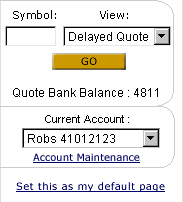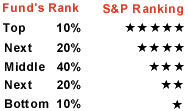We have over 160 fund families
available to you.Click "All" to see every fund family for
which we offer Mutual Fund servicing. Or, click on one of the letters
to explore by alphabetical index.
ALL A
B C
D E
F G
H I
J K
L M
N O
P Q
R S
T U
V W
X Y
Z
Do you know what
you want in a fund but need to find funds that meet your requirements?Click
here for help on searching
Mutual
Fund Investment Objective:
Any Objective
Aggressive Growth Funds
Balanced Funds
Balanced Emerging Market Bond Funds
Currency Funds
Flexible Portfolio Funds
All Sector Funds
-Environmental Funds
-Financial Sector Funds
-Gold Oriented Funds
-Health Funds
-Natural Resources Funds
-Real Estate Funds
-Technology Funds
-Utility Funds
Convertible Funds
Corporate Bond General Funds
Corporate Bond High Quality Funds
Corporate High Yield Funds
Corporate Intermediate Maturity Bond
Funds
Corporate Medium Quality Bond Funds
Corporate Preferred Funds
Corporate Prime Rate Funds
Corporate Strategic Income Funds
Corporate Short Maturity Funds
Corporate Income Mixed Funds
Canada Equity Funds
Chinese Equity Funds
European Equity Funds
Flexible Global Funds
Global Bond General Funds
Global Bond Short-term Funds
Global Equity Sector Funds
Global Government Bond Funds
Global Growth Funds
Global North America Bond Funds
Global Small Company Funds
Global Total Return Funds
Government Adjustable Rate Mortgage
Funds
Government General Funds
Government Intermediate Maturity Funds
Government Mortgage-backed Funds
Government Short Maturity Funds
Growth Funds
Growth and Income Funds
Growth MidCap Funds
Income
International Developing Markets Equity
Funds
International Growth Fund
International Small Company Funds
International Total Return Funds
Japanese Equity Funds
Latin America Equity Funds
Pacific Equity Funds (incl. Japan Funds)
Pacific Equity funds (excluding Japan
Funds)
Principal Return Funds
Single Country Equity Funds
Single Country Bond Funds
Small Company Growth
Specific
Family:
Any Family
AAM FUNDS
AARP
ACHIEVEMENT FUNDS
ACORN FUNDS
ADVANTUS FUNDS
AETNA FUNDS
AIM FUNDS
AIM FUNDS (FORMERLY GT GLOBAL)
ALGER
ALLEGHANY FUNDS
ALLIANCE
ALPINE FUNDS
AMELIA EARHART / CAPITAL MGMT
AMERICAN ADVANTAGE (NO-LOAD)
AMERICAN CENTURY (ADVISOR CLASS)
AMERICAN CENTURY (INVESTOR CLASS)
AMERICAN FUNDS GROUP
AMERICAN GROWTH FUND, INC.
AMERICAN SCANDIA ADVISOR FUNDS
AMERINDO FUNDS
AMERISTOCK MUTUAL FUND
AMIDEX FUNDS, INC. ( LOAD )
AMIDEX35 MUTUAL FUND (NO-LOAD)
AMSOUTH FUNDS
AQUILA GROUP
ARIEL FUNDS
ARK FUNDS (FORMERLY GOVETT)
ARMADA FUNDS (FORMERLY PARKSTONE)
ARTISAN FUNDS
BABSON FUNDS
BARCLAYS GLOBAL INVESTORS ( LIFEPATH )
BARON FUNDS
BARR ROSENBERG SERIES TRUST (AXA ROSENBERG)
BARTLETT & CO.
BEAR STEARNS
BERGER FUNDS
BLACKROCK FUNDS
BRANDYWINE
BRIDGEWAY FUNDS
BULL AND BEAR
CALAMOS FAMILY OF FUNDS
CALVERT
CAPIELLO RUSHMORE
CARL DOMINO
CDC NVEST FUNDS ( FORMERLY NVEST FUNDS
)
CIGNA FUNDS GROUP (CHARTER FUNDS)
COHEN & STEERS
COLUMBIA FUNDS
COLUMBIA PARTNERS EQUITY FUND
CONSECO FUND GROUP
CORNERSTONE MVP FUND
CREDIT SUISSE WARBURG PINCUS FUNDS (COMMON
CLASS)
CREDIT SUISSE WARBURG PINCUS FUNDS (FORMERLY
DLJ)
CREDIT SUISSE WARBURG PINCUS FUNDS (ADVISOR
CLASS)
DAVIS FUNDS
DEAN FAMILY OF FUNDS
DELAWARE
DEUTSCHE ASSET MANAGEMENT (FORMERLY FLAG
INVESTORS )
DEUTSCHE/BANKERS TRUST FUNDS
DIMENSIONAL FUND ADVISORS INC. (DFA FUNDS)
DODGE & COX FUNDS
DOMINI SOCIAL EQUITY FUND
DRESDNER RCM GLOBAL FUNDS
DREYFUS
DREYFUS (NO-LOADS)
DREYFUS FOUNDERS CLASS F FUNDS
DRIEHAUS MUTUAL FUNDS
DUNCAN-HURST MUTUAL FUNDS
EATON VANCE MEDALLION
EATON-VANCE
ECLIPSE FUNDS (FORMERLY MAINSTAY INST
FUNDS)
EMERALD MUTUAL FUNDS (FORMERLY HOMESTATE
FUNDS)
ENTERPRISE
EVERGREEN FUNDS
FBR FUNDS
FEDERATED
FEDERATED (NO-LOAD)
FIDELITY
FIDELITY ADVISOR FUNDS
FIDELITY ADVISOR WORLD FUNDS
FIFTH THIRD FUNDS
FINANCIAL HORIZONS
FIRST AMERICAN FUNDS
FIRST EAGLE FUNDS
FIRST INVESTORS
FIRSTHAND FUNDS
FLORIDA STREET FUNDS
FORTIS
FOUNTAINHEAD SPECIAL VALUE FUND
FRANKLIN TEMPELTON
FREMONT FUNDS
GABELLI
GABELLI (NO-LOAD)
GALAXY FUNDS
GALAXY FUNDS (NO LOADS) BKB SHARES
GE FUNDS
GLOBAL ASSET MANAGEMENT
GLOBALT GROWTH FUND
GOLDMAN SACHS - SERVICE SHARES
GOLDMAN SACHS FUNDS
GREEN CENTURY FUNDS
GUARDIAN FUNDS
HARBOR FUND
HARRIS INSIGHT FUNDS ( N SHARES )
HARTFORD FUNDS (FORMERLY ITT HARTORD)
HAVEN CAPITAL
HEARTLAND FUNDS
HEITMAN
HENNESSY FUNDS (FORMERLY O'SHAUGHNESSY
FUNDS)
HERITAGE ASSET MANAGEMENT
HERITAGE FAMILY OF FUNDS
HIGHMARK FUNDS
HSBC FUNDS
HSBC INVESTOR FUNDS (FORMERLY REPUBLIC
FUNDS)
HSBC INVESTOR MONEY FUNDS (FORMERLY REPUBLIC)
HSBC PREFERRED PORTFOLIOS
IAI FUNDS
ICON FUNDS
IDEX
IMS CAPITAL VALUE FUND
INTEGRITY MUTUAL FUNDS
INVESCO (NO-LOADS)
INVESCO FUNDS ( LOAD )
INVESTEC FUNDS ( FORMERLY GUINNESS FLIGHT
)
IPS FUNDS
IVY MACKENZIE
J.P. MORGAN
J.P. MORGAN FUNDS (FORMERLY CHASE VISTA)
JAMES ADVANTAGE FUNDS
JANUS FUNDS
JOHN HANCOCK FUNDS
JOHNSON FAMILY FUNDS
JUNDT FUNDS
JURIKA & VOYLES FUND GROUP
KEMPER
KENT ADVISOR FUNDS
KENT FUNDS
KINETICS MUTUAL FUNDS
KOPP FUNDS
LEXINGTON (LOAD FUNDS)
LIBERTY FUNDS
LIBERTY-STEIN ROE FUNDS
LIGHT REVOLUTION FUND
LONGLEAF PARTNERS FUNDS
LOOMIS SAYLES ADMIN CLASS
LOOMIS SAYLES FUNDS
LORD ABBETT
MAGNET TOTAL MARKET GROWTH FUND
MAINSTAY FUNDS (LOADS)
MANAGERS FUND
MARATHON VALUE FUND
MARSICO INVESTMENT FUND
MARTIN CAPITAL OPPORTUNITY FUNDS
MASTERS SELECT FUNDS
MATTHEWS FUNDS ( LOAD )
MATTHEWS INTERNATIONAL FUNDS
MERCURY FUNDS (FORMERLY HOTCHKIS & WILEY)
MERGER
MERIDIAN
MERRILL LYNCH
MERRILL LYNCH / BANCO POPULAR
METLIFE / STATE STREET
MFS
MIDAS FUNDS
MMA PRAXIS MUTUAL FUNDS
MONTGOMERY
MONUMENT FUNDS
MUHLENKAMP FUND
MUNDER FUNDS
MUNDER@VANTAGE FUND
MUT FDS N/A
MUTUAL SERIES
NATIONS FUNDS
NATIONWIDE FAMILY OF FUNDS
NAVELLIER
NAVELLIER MILLENNIUM FUNDS
NEUBERGER & BERMAN
NEUBERGER & BERMAN TRUST
NEUBERGER BERMAN EQUITY ASSETS
NICHOLAS FAMILY OF FUNDS
NICHOLAS-APPLEGATE
NORTH AMERICAN
NORTH TRACK FUNDS, INC. (PRINCIPAL PRESERVATION)
NORTHERN FUNDS
NUVEEN
OAK ASSOCIATES FUNDS
OAK VALUE FUND
OAKMARK
OCEAN STATE TAX EXEMPT FUND
ONE GROUP ( FORMERLY PEGASUS )
OPPENHEIMER
ORBITEX GROUP OF FUNDS
PACIFIC CAPITAL
PAINEWEBBER
PARNASSUS INVESTMENTS
PAX WORLD FUNDS
PBHG ADVISOR (LOAD FUNDS)
PBHG FUNDS
PHOENIX
PILGRIM FUNDS (FORMERLY PILGRIM AMERICA)
PILLAR FUNDS
PIMCO FUNDS
PIONEER
PNC CAPITAL DIRECTIONS
POPULAR TOTAL RETURN FUND,INC.
POTOMAC FUNDS
PRINCIPAL FUNDS (FORMERLY PRINCOR FUNDS)
PROFUNDS
PRUDENT BEAR FUNDS
PRUDENTIAL
PUTNAM
PUTNAM COLLEGE ADVANTAGE PLAN (529 PLAN)
QUAKER FAMILY OF MUTUAL FUNDS
RAINIER FUNDS
RANSON MANAGED PORTFOLIOS
REGIONAL OPPORTUNITIES
REICH & TANG FUNDS
RENAISSANCE CAPITAL GREENWICH FUNDS (IPO+
AFTERMARKET FUND)
REYNOLDS FUNDS
RIGGS ( WRAP )
RIGGS FUNDS
RIGGS PREVAIL
RIVERFRONT
ROCKLAND FUNDS TRUST
ROYCE FUNDS
RS FUNDS (ROBERTSON STEPHENS)
RYDEX SERIES FUNDS
SAFECO (NO-LOAD)
SAFECO ADVISOR FUNDS
SALOMON BROTHERS
SALOMON BROTHERS GLOBAL HORIZONS FUNDS
( OFFSHORE )
SARATOGA ADVANTAGE TRUST
SCHWAB FUNDS
SCUDDER
SCUDDER GLOBAL OPPORTUNITIES FUNDS (OFFSHORE)
SCUDDER KEMPER MONEY FUNDS
SECURITY BENEFIT GROUP
SECURITY CAP REAL ESTATE FUNDS
SELECTED FUNDS (NO-LOADS)
SELIGMAN
SENTINEL
SIT FUNDS
SKYLINE
SMITH BARNEY INDEX FUNDS
SOGEN FUNDS
SOUTHTRUST FUNDS
STATE STREET GLOBAL ASSETS (FORMERLY SEVEN
SEAS)
STI CLASSIC FUNDS
STRONG
SUMMIT FUNDS
SUNAMERICA
SUNTRUST 401K
SUNTRUST PREFERRED PORTFOLIOS
SWEEPS
T. ROWE PRICE
TCW GALILEO FUNDS
TEMPLETON GLOBAL STRATEGY FUNDS (OFFSHORE)
THE BRINSON FUNDS
THE RESERVE FUNDS
THE SIMMS FUNDS
THE TIMOTHY PLAN
THIRD AVENUE
THORNBURG FUNDS
TOCQUEVILLE TRUST MUTUAL FUNDS
TORRAY FUND
TOUCHSTONE FAMILY OF FUNDS
TRAINING:TEST FUNDS
TRANSAMERICA PREMIER FUNDS
TURNER FUNDS
U.S. GLOBAL INVESTORS FUNDS
UAM FUNDS
US GLOBAL LEADERS
VALUE LINE (NO-LOADS)
VAN ECK GLOBAL FUNDS
VAN KAMPEN FUNDS
VAN WAGONER FUNDS
VANGUARD
VICTORY FUNDS
VICTORY FUNDS (LOAD FUNDS)
WADDELL & REED ADVISOR FUNDS (FORMERLY
UNITED)
WASATCH FUNDS
WEITZ FUNDS
WELLS FARGO (NO LOADS)
WELLS FARGO FUNDS
WESTCORE FUNDS
WESTPORT FUNDS
WM MUTUAL FUNDS
WRIGHT INVESTORS FUNDS
WST GROWTH FUND
YACKTMAN FUNDS
Your Criteria:
Load
Type:
Any Load
Back End
Front End
Level
No Load
No Load/NTF
Net
Assets (in millions):
Any Size
below 10 million
10 - 99 million
100 - 499 million
500 - 999 million
1 billion and above
Annual
Return (%):
Any
5
10
15
20
25
30
35
40
Over
(years):
Any
YTD
1
3
5
10
Minimum
S&P Rating:
Any
1
2
3
4
5
Minimum
Investment:
Any
$ 500
$ 1,000
$ 2,000
$ 2,500
$ 3,000
$ 5,000
$ 10,000
Expense
Ratio:
Any
Less than or equal to .50%
Less than or equal to 1.00%
Less than or equal to 1.50%
Less than or equal to 2.00%
Sort
your display by:
Fund Name
Load Type
Objective
Net Assets
Rating
Minimum Investment
Expense Ratio
YTD Return
1 Year Return
3 Year Return
5 Year Return
10 Year Return
For broad based searches without specific
enough criteria, only the first 500 funds will be displayed.
Data Provided by : S&P
Fund's Return - Treasury Bill Return


